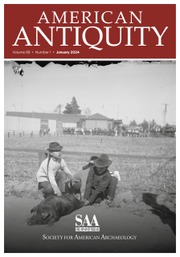Article contents
A Mass Secondary Burial from Northern Arizona
Published online by Cambridge University Press: 20 January 2017
Abstract
A secondary burial of at least 30 individuals was excavated on Polacca Wash south of the Hopi Reservation in Arizona. This burial does not match either the prehistoric or contemporary Hopi pattern and cannot be duplicated in the recorded habits of surrounding tribes. Slight evidence favors a prehistoric placement. The formal arrangement of the burial, with skulls around the periphery and the remainder of the bones within the outline, suggests a magico-religious rite.
- Type
- Research Article
- Information
- Copyright
- Copyright © The Society for American Archaeology 1966
References
Beaglehole, Ernest and Beaglehole, Pearl
1935
Hopi of the Second Mesa. Memoir of the American Anthropological Association No. 44. Menasha.Google Scholar
Colton, H. S.
1946
The Sinagua. Museum of Northern Arizona, Bulletin No. 22. Flagstaff.Google Scholar
Ezell, P. H. and Olson, A. P.
1955
An Artifact of Human Bone from Eastern Arizona. Plateau, Vol. 27, No. 3, pp. 8–11. Flagstaff.Google Scholar
Hrdlička, Ales
1931
Catalogue of Human Crania in the United States National Museum: Pueblos, Southern Utah Basketmakers, Navajo. Proceedings of the United States National Museum, No. 2845, Vol. 78, Art. 2. Washington.Google Scholar
Kluckhohn, Clyde
1944
Navajo Witchcraft. Papers of the Peabody Museum of American Archaeology and Ethnology, Harvard University, Vol. 22, No. 2. Cambridge.Google Scholar
Kluckhohn, Clyde and Reiter, Paul
1939
Preliminary Report on the 1937 Excavations Be 50–51, Chaco Canyon, New Mexico. University of New Mexico Bulletin No. 345, Anthropological Series, Vol. 3, No. 2. Albuquerque.Google Scholar
Kroeber, A. L. (editor) 1935
Walapai Ethnography. Memoir of the American Anthropological Association No. 42. Menasha.Google Scholar
Morris, E. H.
1925
Exploring in the Canyon of Death. The National Geographic Magazine, Vol. 48, No. 3, pp. 263–300. Washington.Google Scholar
Morris, E. H.
1939
Archaeological Studies in the La Plata District, Southwestern Colorado and Northwestern New Mexico. Carnegie Institution of Washington Publication 519. Washington.Google Scholar
Olson, A. P. and Wasley, W. W.
1956
An Archaeological Traverse Survey in West-Central New Mexico. In Pipeline Archaeology, edited by Fred Wendorf, Nancy Fox, and O. L. Lewis. Laboratory of Anthropology, Santa Fe, and Museum of Northern Arizona, Flagstaff.Google Scholar
Parsons, E. C.
1929
Social Organization of the Tewa of New Mexico.
Memoir of the American Anthropological Association No. 36. Menasha.Google Scholar
Robinson, W. J. and Sprague, Roderick
1965
Disposal of the Dead at Point of Pines, Arizona. American Antiquity, Vol. 30, No. 4, pp. 442–53. Salt Lake City.Google Scholar
Schwartz, D. W. and Wetherill, M. A.
1957
A Cohonina Cremation. Plateau, Vol. 29, No. 3, pp. 63–5. Flagstaff.Google Scholar
Stanislawski, M. B.
1963
Extended Burials in the Prehistoric Southwest. American Antiquity, Vol. 28, No. 3, pp. 308–19. Salt Lake City.Google Scholar
Titiev, Mischa
1943
Notes on Hopi Witchcraft. Papers of the Michigan Academy of Science, Arts, and Letters, Vol. 28. Ann Arbor.Google Scholar
Titiev, Mischa
1944
Old Oraibi. Papers of the Peabody Museum of American Archaeology and Ethnology, Harvard University, Vol. 22, No. 1. Cambridge.Google Scholar
Voth, H. R.
1905
The Traditions of the Hopi. Field Columbian Museum, Anthropological Series, Publication 96, Vol. 8. Chicago.Google Scholar
- 11
- Cited by


